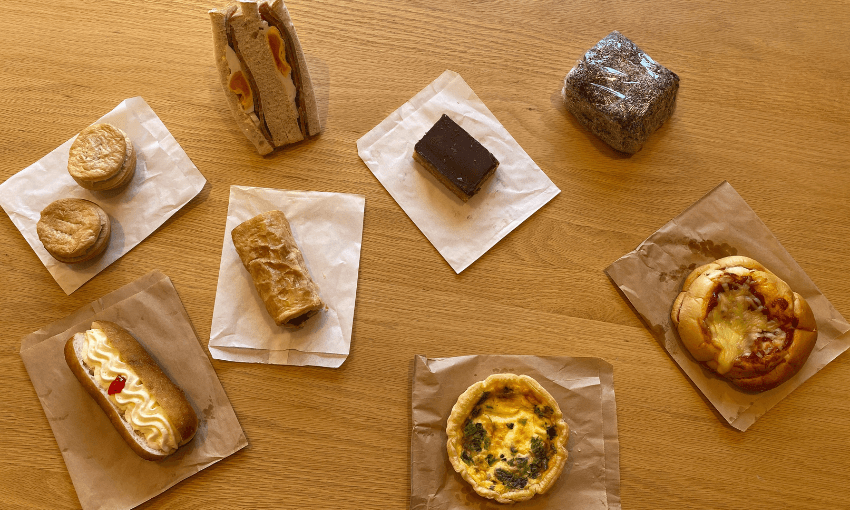Imported mangoes in Aotearoa tend to be fruit that is bred for hardiness, not flavour. People who have grown up with mangoes know what they’re missing.
When someone in the Facebook group finds some, they acquire them for themselves. But there’s too much for one person, so they take a picture, usually, mention the location: if you want them, they’re in Yogiji’s Henderson, say. Get in quick. The comments are a flurry of excitement, then, presumably, people get into buses or cars, ready to get a box for themselves. What they’re looking for is hard to find. What they’re looking for is the good mangoes.
A good mango is creamy and sweet, its pulp melting into your mouth, so orange that when you finish eating it, your fingers are smeared with saffron. Bansari Patel, a gardener and parent living in Wellington, grew up eating mangoes like these; she’s tried dozens of varieties (there are thousands). Kesar mangoes – named for that luminous saffron colour – are one of her favourites.
“The mango is long, with a pointed peak at the bottom,” she describes. “When you chew it, it’s soft and fresh – the juice fills your mouth.” Eating mangoes has always been a sensory experience for her. Growing up in Gujarat, India, she looked forward to the mango season all year, enjoying the succession of different varieties from when the weather warmed to the start of the monsoon season.
For 23 years, mangoes were a beloved part of Patel’s life. Then she moved to Aotearoa, where the mangoes were disappointing and expensive. “I’ve tried Mexican and American and Peruvian and Australian mangoes,” she says, referring to the export varieties that usually make it to supermarket shelves in New Zealand. “Compared to Indian mangoes, nothing comes close.” The mangoes she tried were “stringy” or “crunchy”. “They tend to be more sour, too,” she says. “After you eat them, you need to floss to get out the fibre in your teeth.”
Mangoes don’t travel well; they need to be eaten promptly after being plucked from the tree. The varieties that are imported into New Zealand tend to be grown for hardiness, not flavour, like the notoriously crunchy “Tommy Atkins” variety. While the Ministry of Primary Industries doesn’t keep detailed records of mango varieties, the vast majority of the 9,700 tonnes of mangoes New Zealand has imported over the last three years have come from Peru, Mexico and Australia, where the firm Tommy Atkins (in Mexico and Peru) and the more fibrous Kensington Pride are the most popular varieties respectively.
According to data provided to The Spinoff from MPI, only 1.3% (approximately 127 tonnes) of the mangoes imported into New Zealand since 2020 have come from India. Partially, that’s because most mangoes grown in India aren’t exported at all. Far and away the biggest producer, India grows 45% of the world’s mangoes, and most of those are eaten domestically, with just 32,745 tonnes exported in the 2022/23 financial year. The mangoes that do make it to New Zealand cost about $10 per fruit. While Patel has loved the Indian varieties she’s occasionally found here, it’s a pricey habit.
New Zealand’s biosecurity restrictions don’t help south Asian mangoes make it here, either. Mangoes are known to attract fruit flies, varieties that New Zealand is keen to keep out of the country, says Peter Thomson, animal and plant health director at Biosecurity New Zealand. To get rid of potential pests, fruit either has to be irradiated or heat treated. Think of your favourite juicy fruit – perhaps a peach – and now imagine it being immersed in 50 degree water for an hour, then transported thousands of kilometres by plane. Do you think this would improve the fruit?
Irradiation is the preference for mango connoisseurs, where the fruit is exposed to a harmless amount of radiation to kill germs and pests. There are facilities that can do this in India, but protocol for fruit needs to meet MPI regulations – and as a smaller, distant market, New Zealand isn’t as much of a priority. (Incidentally, this is even more of an issue for people who want Pakistani mangoes, where there are even fewer export-approved irradiation facilities.)
The Indian mangoes that do arrive come in trays of six or 12, tenderly packed in foam to stop them from bruising. They show up, often, in Indian grocery stores. The word gets out. The mangoes disappear.
“Mangoes were an inextricable part of my life, I didn’t have to think about where they came from,” says Sashi*, a mango-lover living in Auckland. I found her in a social media group, asking if anyone knew where to get Indian mangoes. Like Patel, Sashi grew up in India, and was disappointed by the quality of mangoes available here. “Every time I buy mangoes here it ruins my experience,” she says. “They’re kind of without taste.”
A precious box of Indian alphonsos, found in a Sandringham store last year, was her saving grace – as was introducing her husband to mangoes on a trip to India around the same time. “He hadn’t eaten them before – he ate one every morning for two months.” Mangoes are part of the social fabric, too. “You get mangoes from friends, a box as a gift from relatives – they’re a way to show love through food.”
Devoid of the delicious mangoes that she loves, Sashi at least has other mango products. “Without mango pickle, I’d be incomplete,” she says. In India, her mother would make enormous jars of it from fresh mangoes. Now she buys jars. “250 grams is too small – you need big jars that will last forever.”
Patel, too, loves mango products like gotli, a Gujarati speciality of toasted mango seeds dusted with amchur, green mango powder, and served as a palate cleanser after meals. “It looks like tiny wooden sticks – they’re salty and tangy.”
But she still misses fresh mangoes, so she wondered if she could try to grow them herself. Her garden in Wellington happily produces limes and blueberries and strawberries; could it handle a tropical tree?
She was delighted to find kesar mangoes purchased several weeks ago: she made mango-lime raita, fresh mango puree, gave it to her children as a snack. Then Patel saved the seeds and tried to crack them open to sprout them. (Inside the flat woody mango shell is the real seed, a pale oblong.) Her first attempts didn’t work: the seeds were hard to split open, and they started rotting before they properly germinated. She’s been browsing Facebook groups, finding examples of people who have successfully grown mangoes from seed in New Zealand – but admittedly, all of those are based in the northern half of the North Island.
Patel knows she’s working against the odds in Wellington. “The problem is that mangoes need hot weather to flower, not to be hit by harsh winds,” she says. “In Wellington, the wind is strong enough to blow a person over, let alone a blossom.”
Growing exotic fruits in New Zealand is a popular hobby. As I researched this story, I found Facebook groups with hundreds of members dedicated to the pursuit. For people who want to try growing exotic fruit, supermarkets are a good place to start. On YouTube, TheKiwiGrower demonstrates how to rinse the flesh of a dragonfruit to get the seeds out, so they can sprout in water; in the exotic plant Facebook groups, people fish seeds out of the flesh of pineapples and germinate mangoes.
And it works: mangoes have been grown successfully in New Zealand, although John Prince from Nestlebrae Exotics warns that there’s almost always too much rain in spring to lead to a big harvest. There they are, snuggled in greenhouses, glossy leaves tilting to get as much of our low-latitude sunlight as they can. Beneath any post about growing mangoes in New Zealand are people, like Patel, who want some of the mango action for themselves, asking: when should you put it outside? When you do, where do you plant it?
Plants want to grow: taking the seeds of a fruit and tending them to make more of themselves is an ancient, intrinsic part of human cultures. Because while both a fruit and a packet of chips can be bought in a supermarket, only one of these is still alive, able to make more of itself with the right attention and conditions. But while the Facebook groups are enthused about the possibility of buying a fruit and turning it into a plant, MPI doesn’t share that enthusiasm.
“Imported fresh fruit and vegetables that have been purchased from retailers are imported for human consumption, not for planting. If these products or their seeds are planted, they may introduce unwanted pests and diseases into New Zealand,” Thomson says. MPI initially told me the practice was illegal, then issued a correction: growing plants from exotic fruit isn’t against the law, just discouraged.
Exotic fruit fans find this stance out-of-touch and perplexing, and it doesn’t seem to be putting off the social media groups. A post I saw about the MPI position in 2021 kicked off a procession of comments questioning if their backyard mango experiments were really such a concern.
There are currently no documented examples of this practice introducing an unwanted pest into the country. That said, there is currently no commercial importing of mango seeds or seedlings for growing, so it seems likely that fruit fans will keep trying to grow mangoes from imports.
To Patel, who currently has a line of kesar mango seeds drying on her window sill waiting to be cracked open to germinate, the fruit is a point of connection to the place she came from. “My grandfather was a farmer, and his grandfather was a farmer. We love to be in touch with the soil – plants are living beings.” Her daughters love mangoes as much as she does; after our conversation, she sends me a picture of her one-year-old with a massive smile, face covered in glowing orange mango. She doesn’t know if her mangoes will survive, but she’ll keep trying. “It’s a very nostalgic feeling to have mangoes growing, to think: should I put them in the backyard, or out the front?”





